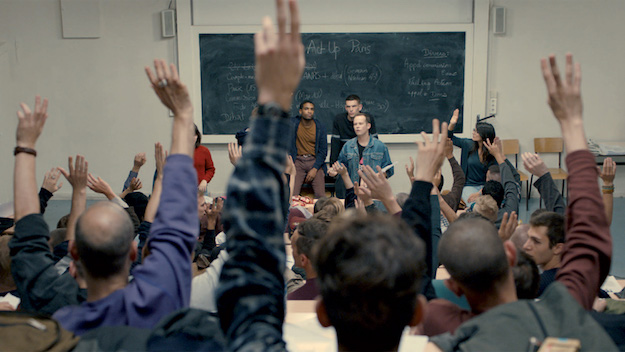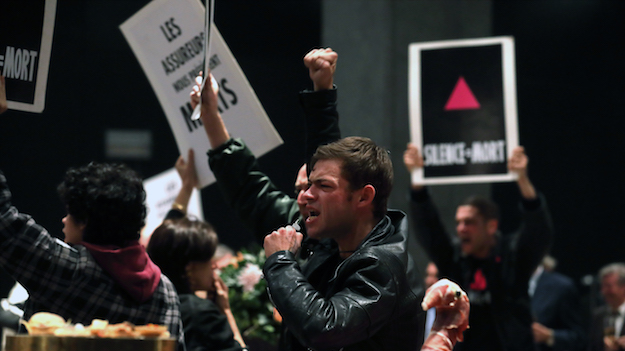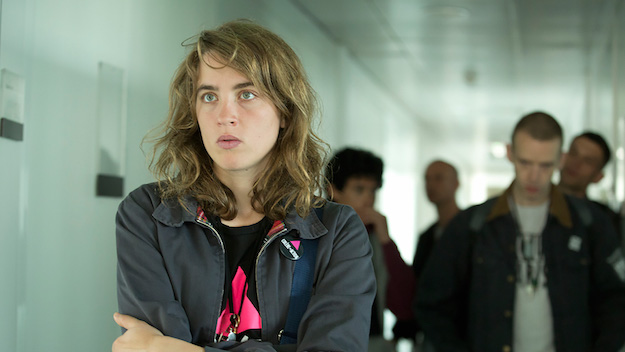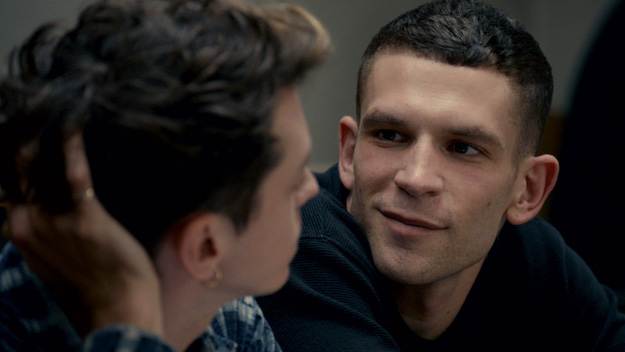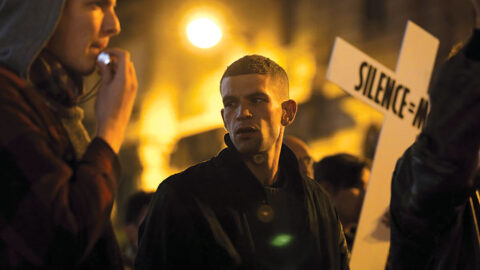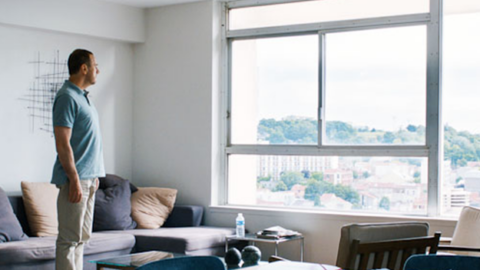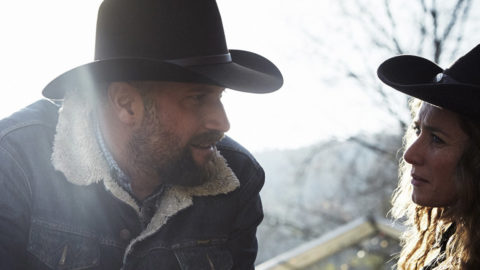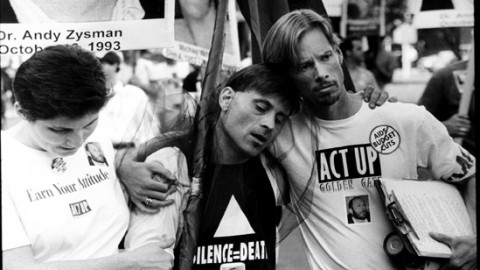Interview: Robin Campillo
At Cannes in May, BPM (Beats Per Minute) won the Grand Prix, with its writer-director, Robin Campillo, accepting the award to a standing ovation. Set in an ACT-UP group in France during the early 1990s, Campillo’s third feature (following They Came Back and Eastern Boys) modulates between scenes of debate and protest among AIDS activists, and more intimate scenes of communion, love, and grief. The film is born along with a somewhat heightened realism (perhaps not so unreal in a crisis) but a notable avoidance of a triumphal narrative of protest and results. Grounding it all are performances, especially, by Nahuel Pérez Biscayart as Sean, an activist who falls ill, and Arnaud Valois as Nathan, a shyer new recruit to the organization. Born in 1962, Campillo joined ACT-UP in 1992 and was an active member, and BPM portrays a chapter in history perhaps less chronicled in France film than it has been in the U.S.
Film Comment spoke with Campillo in May. BPM screens on October 8 and 9 in the New York Film Festival before opening theatrically on October 20.
What was your concept for the look of the film as you thought through this history?
For the beginning of the film, I wanted a contrast between all of these people talking about things they have to do, actions they have to imagine, and then scenes of action which were quite dreamy, oneiric. It was like you were in the brain of a body, and people were talking and thinking of actions, slogans, all those things. And I wanted it to be haunted by the exterior, by the actions. I’m trying to make films with different forms in it, like a metamorphosis. Like you, the film is going through a metamorphosis, because I have this feeling that in everyday life, we go from one form to another—because we are in love, because we take drugs, because we are in a club… It’s not the same perception of the world that we have at different moments, so I wanted the film to recreate this. For me, there was this [activist meeting] place where they are talking, and there was the disco, the club, where they are dancing, which is a place out of the world, dreamy.
I understand what you’re saying, because I felt that we were watching ways of being in a body in the world. We feel these discussions, these meetings, but we also have the meetings of people together in a joyful way, dancing. The film makes it all a continuity of experience: the same person experiences that and many other different roles. Part of the crisis is that it forced you to become—
Another one.
You had to become a politician, you had to become a researcher, you had to become a nurse, a therapist, and you also just had to be a human being and survive yourself.
Like, who else do you have to play?
Right. When you were thinking of representing all this visually, was there any art or photography that helped inspire you?
I was a little bit inspired by an artist from Corsica [Jean-Paul Marcheschi]. He does paintings with fire, like an alchemist. I was inspired by that for the particles that you see in the light, when the virus appears. I was very inspired by non-figurative paintings, because I wanted to go to another level, a very poetic level, especially in the club.
I thought the particles was a beautiful motif—the way you see dust floating in the dance scenes, and then also there’s this sense of a paranoia about another kind of particle. There are good particles and there are bad particles.
It’s very strange, because when I was writing the script, I was thinking, “I want to film the air between the people in the disco.” Not only the people, but the space between them. I realized that in order to do that, I had to find some particles to film between the people because there was nothing! [Laughs]
How do you do that? How do you make particles?
I didn’t put the particles in the air. It’s really what we are breathing when we are in the club, I’m sorry to tell you! We just put the spot [spotlight] up, and these particles appear. Put a mask on when you go to the disco! I was amazed to find this thing, because it’s not like something I was forced to create, it’s something that was here already. But when you put a light on it, it does appear, and it’s quite magical to create these strange images. I was very fascinated by that.
That’s also what the movie generally is doing: shining a light on all aspects of a certain era in history.
I hope so, but if you think that of the film like this, I’m very happy! It was very challenging, because the film looks like something very realistic, and I wanted this realism to become more weird and more dreamy. That was really important for me.
It makes sense that things would feel hyperreal, more than real, at a time like this. I’m curious, did you want to avoid anything that was done in other films about the history of AIDS at all? Did you watch How to Survive a Plague?
I didn’t see that one. I saw Silverlake Life [The View from Here]. It’s about a couple, and one of the guys is filming his boyfriend, who is ill and dying. You have the corpse at the end, you know. I was thinking of this film, because for me, it’s a film which is so strong about the disease. But I didn’t want to represent the disease too much, because I thought it was so real in Silverlake Life. It’s a documentary, not a fiction. I didn’t want to make the same thing because you can’t do more than this film, because it was real and it’s a very, very moving film. I love it so much.
I wanted, at the end of my film, to show Sean like he’s in a tunnel of death, like he’s absolutely alone, not reachable at all. It was more about loneliness than disease that I wanted to represent at the end of the film. Because my mother died a few months before I finished the script, and when she was in the hospital, it reminded me of the friends I knew at this moment, because people, at some point, are in a very strange state. You have a very weird contact with them because it is like they are in a tunnel, in another place that we can’t imagine. I wanted to represent that more than the Kaposi’s sarcoma or this kind of thing. I wanted to show this intuition that the person is ultimately in a place that is closer to death than to life.
It really does feel that way when you visit someone very ill in a hospital. You’re going to another place.
And of course, on AIDS, I saw Philadelphia. But the film is so different. I wouldn’t compare with it. I kind of like Philadelphia because it was very important at that moment. In France, we didn’t have anything. That was a very important thing in France. I don’t know about in the United States, but for us it was important, because you had big stars… I have not seen it recently so I don’t know if I would like it so much today.
What was the first French film about AIDS that struck you?
There was a film in France called Les Nuits Fauves [Savage Nights] that I didn’t like at all. It was about a straight couple: the guy was bisexual and he was HIV positive, and he contaminated the girl. I think the moral of the film was that if there’s love, you don’t need to use condoms. So I was a little bit against this message—I was active [in ACT-UP] at the time. It was impossible to accept this point of view which I think was very stupid, very French: “If you’re in love, you can take risks, no problem.”
It sounds like a mindless romanticism.
Yes, and it was inspired by a true story, which was worse.
Coming back to your film, I want to ask about the love scenes. How did you approach filming them with the actors, Nahuel and Arnaud?
First of all, I won’t hide from you the fact that I like to do this kind of thing. I take a lot of pleasure, and it’s not like I’m a voyeur—I have a real pleasure to work on this with actors, to know how to approach it. We did a test, and I told the actors to do the scene but without being naked, just topless. I wanted them to understand that it’s a scene like the other scenes: they have something to play. It’s not apart from the rest of the film, it’s the same thing. So I wanted them to feel confident about that, and to realize that it’s complicated to play the scene, which is long. I did not want to make a scene with too much performance in sex. Of course, there’s a lot of passion between them, but it’s kind of maladroit. They are not very good at it. It’s not perfect, what they’re doing. I’m interested in the fact that, when you do a sex scene in cinema, especially in French film, I think, you start the scene, they’re already naked, and they do all of the Kama Sutra. I hate that, because what I want to show is that you have to get naked, and then you have all of those things which are important, and which are besides the sex. So I like to show how they are very excited by the fact that they have sex, and that they want to have sex, and everything, but I wanted to show that it is not so easy when one man has an orgasm, and the other one not. And after, they talk about their families. So it’s a real scene.
I love the fact that they are naked and they are talking about different things, and I love also that because they are talking about their previous experiences, their former lovers appear like ghosts. I love that it’s not two people alone in a bed—they are not alone, in fact, you can feel a lot of people. I wanted to see all of those bodies together in this bed. It’s like a séance, like they are calling back other bodies with them. I love this idea.
I must say also that it’s very well done because of my actors. Arnaud, who plays Nathan, has this incredible ability, because he looks so much in love. That’s a very nice thing to say, but it’s not so easy to do. He’s amazing. I told them, we won’t see your sexe [genitals], I promise, so feel free to play this as though you were really making love. Don’t worry. So it was interesting because you don’t see so much face, but there’s even the feeling that you can feel the penetration. And it’s all because of them, because they had this commitment in the film and in the scene. I can see that it’s just two actors playing, but it doesn’t bother me, because I have this feeling that I feel so much their bodies because they are not obsessed by the idea that we are going to see their sexe, or anything. It’s quite modest, but at the same time it’s a little bit crude because they are doing it very intensively.
At the same time, I filmed all of that with two cameras, because I don’t want them to do it for too much time, because that’s not possible. They can give themselves only so much. We’d do it twice and that was enough. I’m not manipulative like this. It’s very hard for them.
Having the two camera angles also prevents it from becoming too much like a tableau, too perfect-looking.
Exactly. It’s a little bit random. And so sometimes it’s a bit beautiful because the camera tries to find a good angle, and it’s not perfect, and I love that, because it’s not too arty or too composed. I don’t want it to be like a painting. But I get the feeling that you can see the skin more in this case. Because you can see it’s not prepared. That’s why I did it like this.
There’s a genuine warmth and beautiful intimacy to the scene.
Because they look very much in love, too. It’s very important for me.
That’s part of what’s special about the film. You can have a scene like that, and then also these meeting discussion scenes we were talking about earlier. You get another feeling there of collective conflict and discussion, a mix of the intellectual and action in those scenes. I was curious if you’ve seen the films of Frederick Wiseman at all.
Yes. I mean, I didn’t think of him during this film, but I’m sure there was something in my mind because I am really fascinated by the way he films. There’s something very emotional in his way of observing humans. I saw a film, in a hospital—
The long one about people about to die? It’s called Near Death.
It is an amazing film, really. To be honest, I didn’t think of this film until now because you mentioned it, but maybe it was someplace in my mind. I have this feeling that the films of Wiseman are so emotional about reality. It’s like people are absolutely equals in his films. You have the feeling that he can touch people. People sometimes compare my film to the Dardenne Brothers, and I’m not sure that it’s so close, but you’re right about Wiseman. I tried to do something like this, to have this feeling that, as I say of the sex scenes, it’s not too prepared. The film does have something to do with documentary because for instance with my cinematographer, Jeanne Lapoirie, we decided to shoot very quickly every day. Half an hour after the beginning of shooting, we’d do the first take. We have three cameras, like live TV, and we do the first take, which is very bad. But it’s very interesting because we see all the problems, and we do all of the film like this. We don’t cut, we do all of the film, and we make different takes during the day.
What is good, at the end during the editing, is that sometimes I can use the first takes with improvisations, which are interesting for the fiction, and I can use the last takes, which are more professional, and I can mix these two things to give the impression that sometimes the person who is talking are a little conflicted about what they are saying, and sometimes I make them a little bit unsure of their lines, so they look a little bit stupid (or this kind of thing). I mix all that to create this impression of truth. I let them do all the scenes and I try to film all the problems and all the good moments—it’s maybe close to something like Wiseman, because it’s like I’m doing a documentary about actors playing.
There’s a realism, because some parts of life feel more scripted.
Exactly. In fact, the real thing is that we are in different moments, in different phases, and we are playing [acting]. I’m not exactly the same Robin Campillo when I’m with you in this dialogue when I go home, or when I’m going to have dinner later with some friends of mine. I won’t be the same actor, or be acting the same way. It’s something about cinema. I have this feeling that sometimes in cinema, characters are so scripted that it’s like they just explain the fiction. It’s more interesting when people are contradictory or paradoxical. Because we are. I hope we are, at some points.
It’s exactly the same thing about the form of the film, as I said. Sometimes when I see films, I’m a little bit bored when you see that after a quarter of the film, you know all about the aesthetic of the film. It will be the same until the end. There’s no mutation of that. For me, I don’t feel like this, because I don’t feel life like this. You are not the same person, as I said, when you are in love, when you are on drugs, when you are in the disco, when you are in the cinema. You are not the same person. You are really different. And when you are ill, you are very different, and that’s what I wanted to show, because it takes you, it drags you out of life so much. You know, I told my actor, Nahuel Pérez Biscayart, when he’s in the hospital, “Now you stop to play. You are not playing a character, you don’t play at all.” It was very difficult for him because he likes to play, and he’s very baroque in his way of playing, and he tries to underplay more, and that was very strong, because for the spectator it’s connected to the disease.
Finally, I wanted to talk about the choice of music, which also sets up the moment. Are these mostly dance tracks from the period?
In fact, most of the music is from my composer [Arnaud Rebotini]. There are only two that are not: the Jimmy Somerville song, “Smalltown Boy,” is of course not from my composer, but he did a ’90s-style mix of the Jimmy Somerville, and there’s another song from a guy called Mr. Fingers which is called “What About This Love.” The rest is done by this composer, who was also a DJ during this period, so he knew exactly what was going on in the clubs. He also had instruments, a synthesizer, from this period, so he could play on them and recreate the sound of the moment a bit. What’s interesting is that he is also choosing natural instruments, like flutes. That’s very good because you can go from dance music to more normal film music. You can modulate all that.
The house music of this moment was a little bit… not sad, but sometimes a bit anxious, I thought. For me, it was like the music of the epidemic, in my mind. So we tried to recreate this melancholy, even if it’s in the club. We did the music a long time ago, before the shooting, because he is a little bit slow. I made him work very quickly. So he did this music, and then when we did the last scene of the movie where they are all dancing with the strobe light, we had the music. That was very beautiful to see because the actors were dancing to the real music of the film, and it was like a gospel, like religious music. They were dancing like they were—not praying, but there was something very weird and beautiful to it.
Like a ritual dance or ceremony.
Exactly. It was something like a ritual.



